- News
- Reviews
- Bikes
- Accessories
- Accessories - misc
- Computer mounts
- Bags
- Bar ends
- Bike bags & cases
- Bottle cages
- Bottles
- Cameras
- Car racks
- Child seats
- Computers
- Glasses
- GPS units
- Helmets
- Lights - front
- Lights - rear
- Lights - sets
- Locks
- Mirrors
- Mudguards
- Racks
- Pumps & CO2 inflators
- Puncture kits
- Reflectives
- Smart watches
- Stands and racks
- Trailers
- Clothing
- Components
- Bar tape & grips
- Bottom brackets
- Brake & gear cables
- Brake & STI levers
- Brake pads & spares
- Brakes
- Cassettes & freewheels
- Chains
- Chainsets & chainrings
- Derailleurs - front
- Derailleurs - rear
- Forks
- Gear levers & shifters
- Groupsets
- Handlebars & extensions
- Headsets
- Hubs
- Inner tubes
- Pedals
- Quick releases & skewers
- Saddles
- Seatposts
- Stems
- Wheels
- Tyres
- Health, fitness and nutrition
- Tools and workshop
- Miscellaneous
- Buyers Guides
- Features
- Forum
- Recommends
- Podcast
review
£1,870.86
VERDICT:
Versatile and configurable tourer that's more adventure-friendly than ever
Hugely comfortable
Easy to maintain
Lots of braze-ons
Capable on a wide range of surfaces
Lots of size options
Single rear mounting point
Big tyres can be a bit vague
Mechanical discs lack the bite of hydraulics
Weight:
14,150g
Contact:
At road.cc every product is thoroughly tested for as long as it takes to get a proper insight into how well it works. Our reviewers are experienced cyclists that we trust to be objective. While we strive to ensure that opinions expressed are backed up by facts, reviews are by their nature an informed opinion, not a definitive verdict. We don't intentionally try to break anything (except locks) but we do try to look for weak points in any design. The overall score is not just an average of the other scores: it reflects both a product's function and value – with value determined by how a product compares with items of similar spec, quality, and price.
What the road.cc scores meanGood scores are more common than bad, because fortunately good products are more common than bad.
- Exceptional
- Excellent
- Very Good
- Good
- Quite good
- Average
- Not so good
- Poor
- Bad
- Appalling
The Thorn Club Tour is a very versatile bike, and built like this it's a jolly tractor of a thing that's comfortable on the tarmac and off it. Add some luggage and it's the kind of bike that you could roll out of your garage, hop on and ride to pretty much anywhere in the world, whether the roads go there or not.
The Club Tour is now on its fifth incarnation, and it's a design classic that's stood the test of time: a Reynolds 725-tubed, externally routed steel touring frameset with as many braze-ons as you're likely to need. Thorn's sizing is worthy of note: The Club Tour Mk5 is available in five sizes from 50-61cm, with a long and a short option in each, making ten sizes in total. That allows you to fine-tune your fit both for your size and what kind of riding you're likely to be doing, offering a more upright and a longer, more stretched-out position.
The main change for the Mk5 is that Thorn has done a bit of work with the shaping of the stays so that the bike can now accept 650B wheels as well as 700C. The frame is compatible with either disc or rim brakes and there's a set of bosses on each chainstay to allow you to fit cantilever posts in either the 650B or 700C position, and a classic ISO disc mount externally located on the dropout that will take up to a 180mm disc.
The frame is mated with Thorn's new disc-only Mk3 fork which uses a Boost-standard 15x110mm thru-axle to beef up the front a bit. The frame is a standard 135mm quick release, so you'll need a very specific set of wheels built up in 650B or 700C depending on your preference. Our bike was specced with 650B wheels (Shimano Deore hubs and Ryde rims) and Schwalbe's excellent G-One Allround tyres in a 57mm width. That's a lot of tyre, but there's plenty of room in the Club Tour to fit them, even with full mudguards. Thorn reckons you can fit a 70mm tyre in there.
One of the selling points of the Club Tour is its versatility: the way it's designed means that you can start with the frame and end up with very different bikes, depending on what you use to put it together. Our test bike had a 3x10-speed derailleur transmission and STI levers on a drop bar (Shimano 105 levers and Deore mechs and chainset), but you could equally go for flat bars, or bar-end shifters, or even down tube shifters if you wanted.
Similarly, we tested a disc build but the frame also accepts cantis or V-brakes, and you can spec a rim-brake fork to match if you want.
The ride
Our test bike, with its big tyres and wide-range gears and comfy Brooks B17 saddle, is ideally set up for some serious touring, which isn't really a type of riding that's advisable right now, but I've taken the Club Tour out on local rides on a variety of surfaces, both loaded and unloaded, and I have to say I'm impressed by its ride quality and versatility.
You don't need more than about 40psi in the Schwalbe tyres to get a bike that feels reasonably efficient on the road, but there's enough air under your rims to make the bike really comfortable over broken surfaces, and on fire roads and trails the G-Ones have plenty of bite, especially in the dry.
I started with some graded trails and ended up doing everything up to some of the more technical local bits on the Thorn, and although it wasn't the ideal bike for steep, rocky descents it can handle them well enough. The ideal riding for this build would be a mix of asphalt and gravel, but if you found yourself in more challenging terrain then you'd have plenty of capability in reserve without feeling that you're giving away too much on the blacktop.
The long wheelbase and generous trail on this bike mean that the steering can sometimes feel a bit vague at low speed, especially if you're running the tyres a bit soft for off-road use. But at cruising speeds the bike behaves very predictably, and if you load the fork with panniers then the slower steering will likely be welcome.
Given that the Club Tour is a bike that's almost always going to be running a rear rack it seems odd that the Thorn doesn't have two mounting points on the rear dropout for mudguard and rack. It's not a huge issue, but neither is it a tricky thing to do: there's plenty of space there.
If you were really worried about overloading the mounting bolt you could always migrate the mudguard to the upper disc mounting bolt on the one side, so that at least one of the mounts isn't doubled up.
Other than that, you're not short of places to put stuff. There are low rider bosses on the fork, two standard bottle mounts in the main triangle and a third on the bottom of the down tube.
You don't quite get the wealth of mounting points you might on a bikepacking bike, but here the expectation is that you'll be fitting racks and using traditional luggage, and the bike is very well set up for that.
Choose your own spec
In terms of the build it's not really worth picking holes in anything particular: this is the build we asked for, after all, and like I've already mentioned you can build it up pretty much any way you fancy. I'd be happy to roll this bike out of its big box, pump the tyres up (not too hard), bolt on some carrying capacity and head off on any length of trip you care to imagine.
The triple chainset (48/36/26) and wide ratio cassette (11-36T) give you a huge range of gears, though it's worth noting you could go bigger at the back (say an 11-42T) if you were going to be attempting steep or unmade climbs with a full load; you're much more likely to run out of ratios going up than down.
Although the TRP Spyre mechanical disc brakes lack the bite of hydraulics they're still very efficient, and also extremely easy to set up and fiddle with. I'm a big fan of hydraulic disc brakes but I'd forgo the performance benefit for the bodge-ability of cable discs if I was going anywhere remote.
Similarly with the cable routing: everything's in plain view, which makes for a slightly shorter maintenance cycle than internal cables but also means that getting things fixed out in the field is a whole lot more straightforward.
Value and conclusion
This build comes in at a grand total of £1,870.86. That's a fair whack for a touring bike, and similar to the Genesis Tour de Fer 30, which has a slightly lower spec overall but does come with racks and dynamo lighting. A Surly Disc Trucker comes in a bit under this price in a 3x10 build with bar-end shifters. The Trek 520 is good value at £1,300, albeit with a lower spec, and the Dawes Ultra Galaxy is £100 less than that, with a similar build. Those two bikes don't have the kind of clearances the Thorn gets, though the more bikepacking-orientated Trek 920 (£1,700) does. Salsa's Marrakesh is another option, with a Shimano Sora build coming in a bit more expensive than the Thorn.
> Buyer’s Guide: 15 of the best touring bikes
Anyway, it's not cheap, but if you're looking for something you can build to your exact specifications and depend on to do the job, it should be one for the list. That job could be anything from the commute, and lugging the shopping once a week, to tackling the Carretera Austral or the Karakoram Highway. So long as you're not in a big hurry, I'd back the Club Tour to get you there.
Verdict
Versatile and configurable tourer that's more adventure-friendly than ever
road.cc test report
Make and model: Thorn Club Tour Mk5
Size tested: 61S
About the bike
List the components used to build up the bike.
Frame:
Full (8 tube) Reynolds 725 tube set.
Modern light touring geometry - responsive and fun to ride, comfortable and very stable. Identical to the iconic Club Tour Mk4 - except that thanks to the cranked and shaped chain stays, this frame can ALSO take 650b wheels with up to 57mm tyres - which give it the potential to be a monster gravel bike, a bike for reasonably lightweight adventure touring or simply super comfortable!
NOTE: 650b tyres narrower than 50mm will reduce pedal cornering clearance!
For rear disc brake or rear V brake.
Sloping top tube.
Clearance for 700c tyres from 32c to 40c max with mudguards.
Clearance for 650 x 50b to 650 x 57b tyres!
Stainless fittings for direct fit mudguards, rear carrier, 3 bottle cages, bosses for down tube levers (or more likely) adjustable cable stops, guides for brake and gear cables.
ISO disc mount (max diameter 180mm) and removable and/or reversible bosses for V brake - it can run discs or V brakes with 700c or 650b!
Complete with micro adjusting 27.2mm seat post and high quality FSA aerospace bearing 1.25'
Fork:
- For disc brake only
- Through axle 15 x 110mm included, for boost hubs only
- High quality Reynolds steel blades and Cr-Mo steerer
- Thorn Twin Plate Crown is lightweight, very stong and gives more clearance and increased comfort compared to various unicrown designs
- Suitable for a variety of tyre sizes
- Stainless steel fittings for direct and secure mounting of mudguards
- M6 Fittings for mudguard stays and lo-loader front carrier
- ISO Disc mount
- Steerer: 1 1/8"
- L1 Dimension (Axle to Crown Race Seat): 410mm
- NOTE: Does not include crown race seat
Sufficient clearance to be used with mudguards and;
- 26" tyres up to 2.8"
- 650b tyres up to 60b
- 700c tyres up to 40c
Sufficient clearance to be used without mudguards and;
- 26" tyres up to 3.0"
- 650b tyres up to 70b
- 700c tyres up to 50c
Available in 3 different offsets to suit the following Thorn frames;
- Mercury Mk3
- Club Tour Mk5
- Nomad Mk3
Available in three different offsets to suit the corresponding Thorn Nomad Mk3 frames.
A = 48mm - suitable for: 55L, 58L, 61S, 61L
B = 53mm - suitable for: 47S/T, 50L, 52L, 58S
C = 60mm - suitable for: 40S/T, 50S, 52S, 55S
Tell us what the bike is for and who it's aimed at. What do the manufacturers say about it? How does that compare to your own feelings about the bike?
Thorn says, 'Modern light touring geometry - responsive and fun to ride, comfortable and very stable. Identical to the iconic Club Tour Mk4 - except that thanks to the cranked and shaped chain stays, this frame can ALSO take 650b wheels with up to 57mm tyres - which give it the potential to be a monster gravel bike, a bike for reasonably lightweight adventure touring or simply super comfortable!'
Where does this model sit in the range? Tell us briefly about the cheaper options and the more expensive options
There isn't really a 'range' of Thorn touring bikes, they're more specific frames for specific purposes. This is Thorn's "take on a traditional touring bike".
Frame and fork
Overall rating for frame and fork
9/10
Tell us about the build quality and finish of the frame and fork?
Neatly welded, nicely finished. Red is bold, also available in gunmetal, British Racing Green and blue.
Tell us about the materials used in the frame and fork?
Full Reynolds 725 tubeset.
Tell us about the geometry of the frame and fork?
Our 61S bike has an effective top tube of 575mm and a 214mm head tube, but there's also a 61L that's 40mm longer and a bit lower. All the sizes are available in two lengths so you should be able to get a good fit.
How was the bike in terms of height and reach? How did it compare to other bikes of the same stated size?
It fitted me very well.
Riding the bike
Was the bike comfortable to ride? Tell us how you felt about the ride quality.
Very comfortable, easy to get on with.
Did the bike feel stiff in the right places? Did any part of the bike feel too stiff or too flexible?
Absolute stiffness isn't the main aim of a tourer but it's plenty stiff enough to cope with loads and the weighting they put upon the frame.
How did the bike transfer power? Did it feel efficient?
Yes, especially when seated.
Was there any toe-clip overlap with the front wheel? If so was it a problem?
A bit of overlap due to the mudguard but nothing to worry about.
How would you describe the steering? Was it lively neutral or unresponsive? Relaxed.
Tell us some more about the handling. How did the bike feel overall? Did it do particular things well or badly?
It's a pretty relaxed ride, great for cruising with minimal input.
Which components had the most effect (good or bad) on the bike's comfort? would you recommend any changes?
The 57mm tyres soak up a lot of surface chatter. I'd probably go a bit thicker on the bar tape. Brooks saddle was comfy out of the box.
Which components had the most effect (good or bad) on the bike's stiffness? would you recommend any changes?
I wouldn't really change anything.
Which components had the most effect (good or bad) on the bike's efficiency? would you recommend any changes?
You could make the bike more efficient on the road with a slightly narrower and less aggressive tyre, say a 40mm Schwalbe G-One Speed. That's at the expense of its off-road capability though.
Rate the bike for efficiency of power transfer:
7/10
Rate the bike for acceleration:
4/10
It's 15kg so you work your way up to speed.
Rate the bike for sprinting:
1/10
Not really a sprinter's bike.
Rate the bike for high speed stability:
8/10
Rate the bike for cruising speed stability:
10/10
Rate the bike for low speed stability:
8/10
Rate the bike for flat cornering:
8/10
Rate the bike for cornering on descents:
7/10
Rate the bike for climbing:
6/10
Plenty of gears, plenty of weight.
The drivetrain
Rate the drivetrain for performance:
9/10
Rate the drivetrain for durability:
9/10
Rate the drivetrain for weight:
6/10
Rate the drivetrain for value:
7/10
Wheels and tyres
Rate the wheels for performance:
8/10
Rate the wheels for durability:
9/10
Rate the wheels for weight:
6/10
Rate the wheels for comfort:
7/10
Rate the wheels for value:
6/10
Rate the tyres for performance:
9/10
Rate the tyres for durability:
8/10
Rate the tyres for weight:
7/10
Rate the tyres for comfort:
10/10
Rate the tyres for value:
6/10
Controls
Rate the controls for performance:
8/10
Rate the controls for durability:
8/10
Rate the controls for weight:
7/10
Rate the controls for comfort:
7/10
Rate the controls for value:
6/10
Anything else you want to say about the componentry? Comment on any other components (good or bad)
You can spec the bike how you want, so picking on things here wouldn't be that helpful, but I didn't have any complaints really. Maybe a thicker bar tape, but that's it.
Your summary
Did you enjoy riding the bike? Yes
Would you consider buying the bike? Yes
Would you recommend the bike to a friend? Yes
How does the price compare to that of similar bikes in the market, including ones recently tested on road.cc?
It's nearer the top end than the bottom given the spec, but you wouldn't say it was bad value. Bikes like the Salsa Marrakesh and Genesis Tour de Fer are broadly comparable to this build, but with the Thorn you get the benefit of being able to custom-spec bits and bobs which isn't an option on mass-produced bikes.
Rate the bike overall for performance:
9/10
Rate the bike overall for value:
6/10
Use this box to explain your overall score
It's a really good and versatile touring bike, and built like this is a lot more capable than just sticking to the tarmac. It's not cheap but it does represent decent value.
About the tester
Age: 47
I usually ride: whatever I'm testing... My best bike is: Kinesis Tripster ATR, Merida Scultura, Dward Design fixed
I've been riding for: Over 20 years I ride: Every day I would class myself as: Experienced
I regularly do the following types of riding: road racing, time trialling, cyclo cross, commuting, touring, club rides, sportives, general fitness riding, fixed/singlespeed, mtb, Mountain Bike Bog Snorkelling, track
Dave is a founding father of road.cc, having previously worked on Cycling Plus and What Mountain Bike magazines back in the day. He also writes about e-bikes for our sister publication ebiketips. He's won three mountain bike bog snorkelling World Championships, and races at the back of the third cats.
Latest Comments
- Rendel Harris 2 min 15 sec ago
Indeed, I was drawing from personal experience – I don't use it that often but it's such a nice bit of infrastructure that I sometimes go out of my...
- paulgardener@gmail.com 6 min 20 sec ago
Except socialism doesn't work like that in real life. It's the capitals countries that try to look after those in need, and the average person's...
- Patrick9-32 21 min 20 sec ago
2020/2021: Bike companies place large orders to attempt to fill pandemic orders which go unfulfilled due to massive lead times. Leaving many bike...
- David9694 42 min 1 sec ago
'I racked up thousands in Ulez fines - I misread the rules and my dog ate the letters'...
- KDee 1 hour 3 min ago
It's the mass that's the issue. Two people on a petrol powered scooter can really mess up a cyclist. Also the fact so many of the petrol scooters...
- james-o 1 hour 13 min ago
"if we’ve got to fly there we’re not going" *applause from over here*
- KDee 1 hour 14 min ago
"Strumpjumper"...sounds like a euphemism for something else 🤔
- andystow 1 hour 30 min ago
The new RH tubes claim to solve that issue, but price and availability is a problem. I tried to get some to try out, but they went out of stock on...
- brooksby 1 hour 55 min ago
Cough - cough - Clevedon seafront! - cough cough
- Secret_squirrel 5 hours 25 min ago
Those calipers arent the prettiest. Makes them look like Post-mount.













































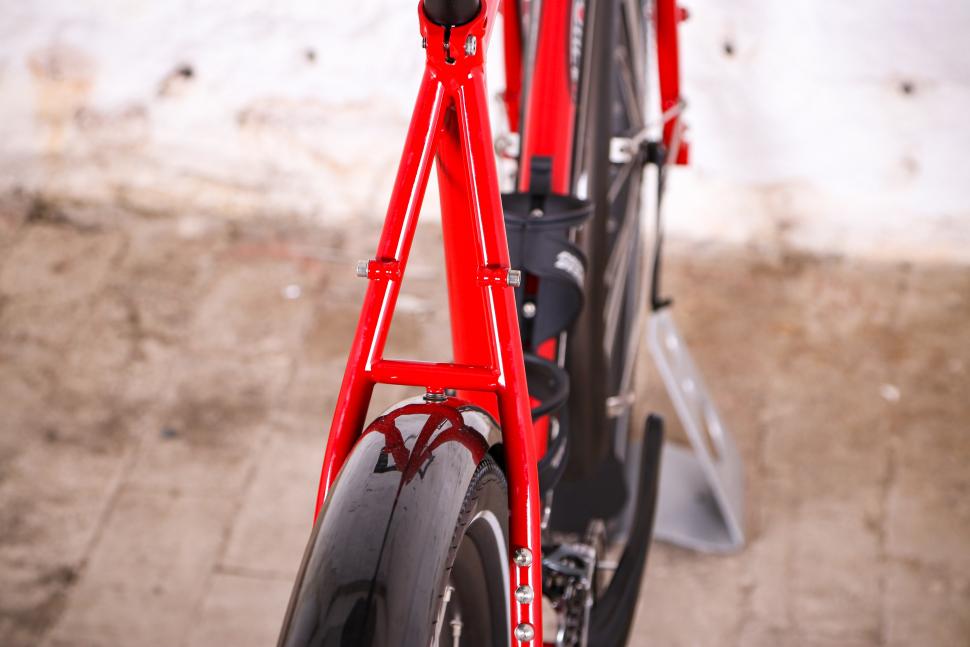

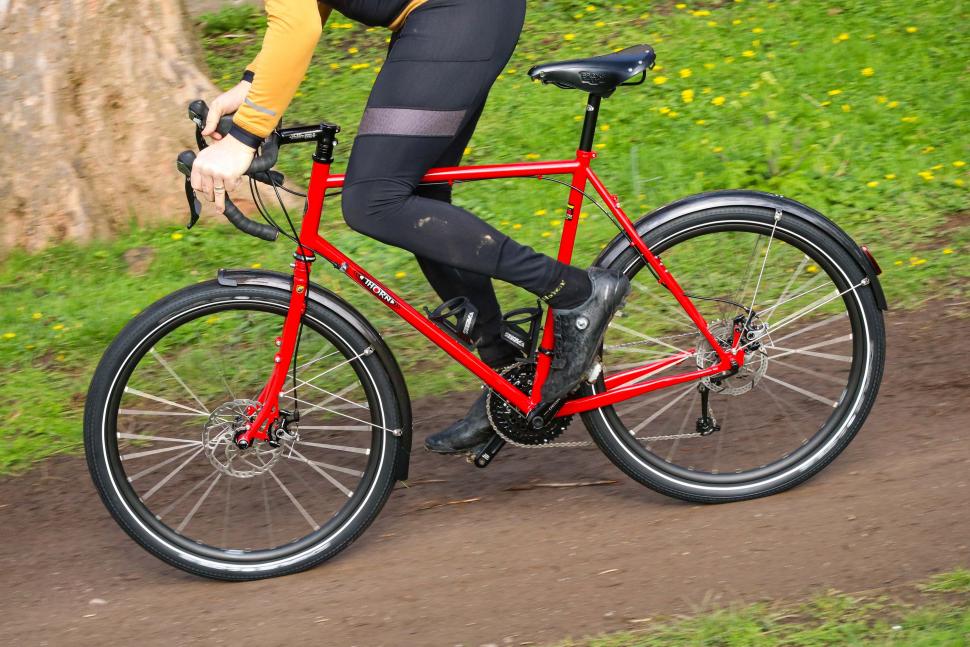
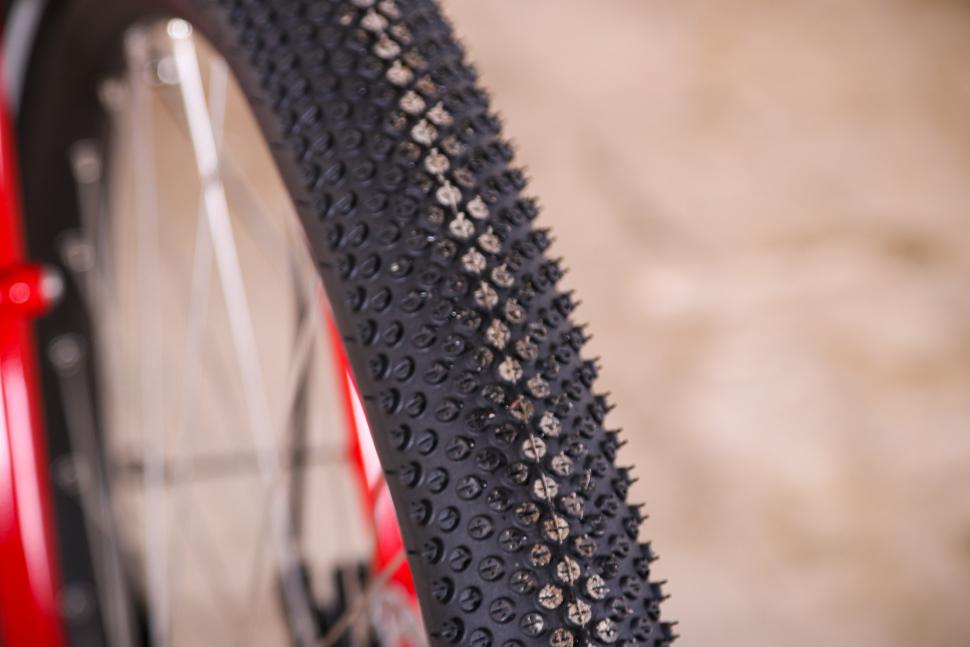
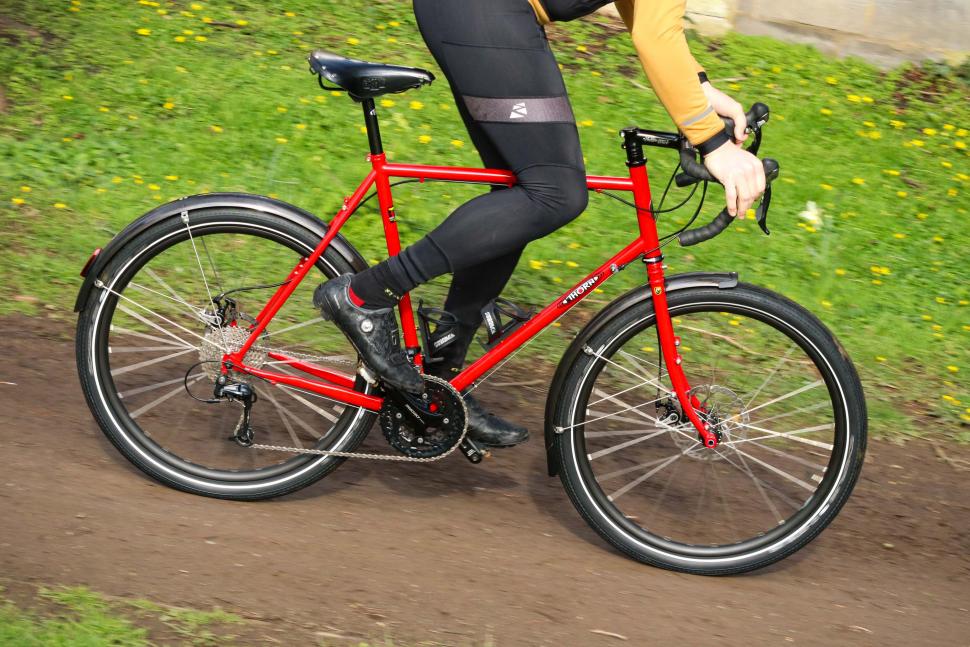
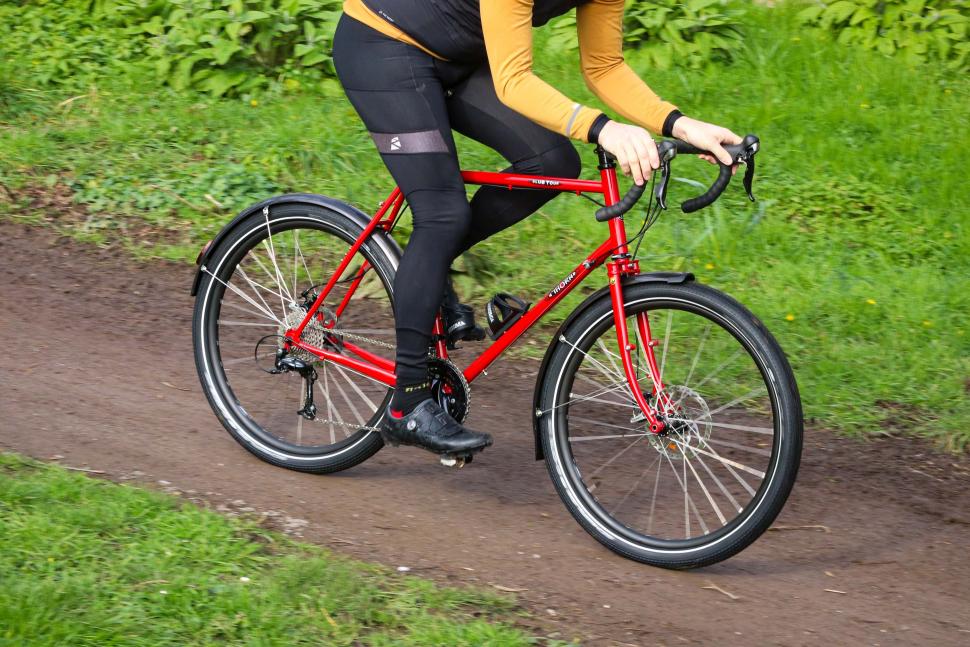

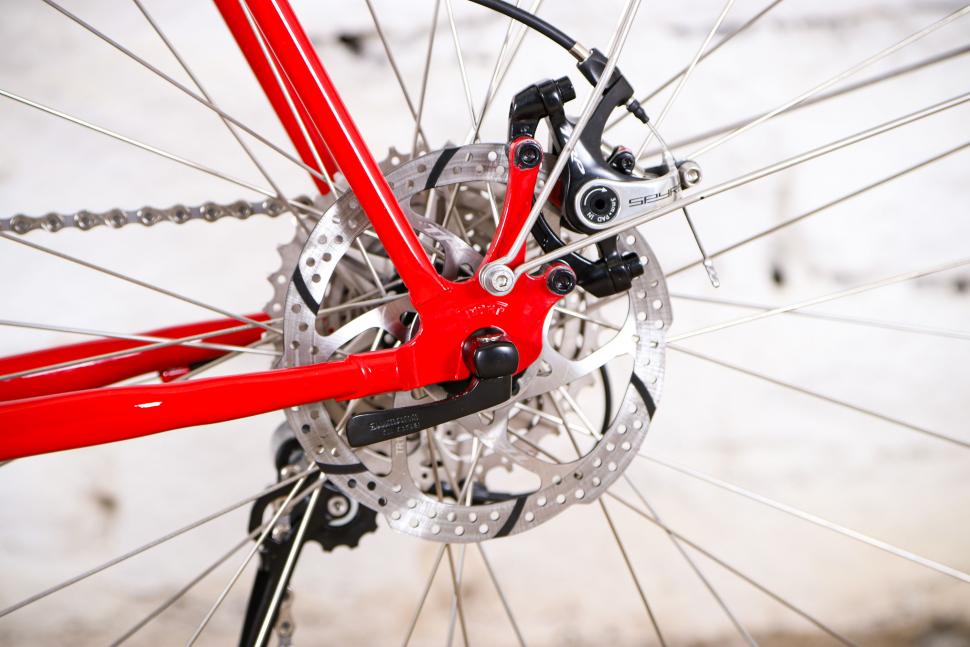

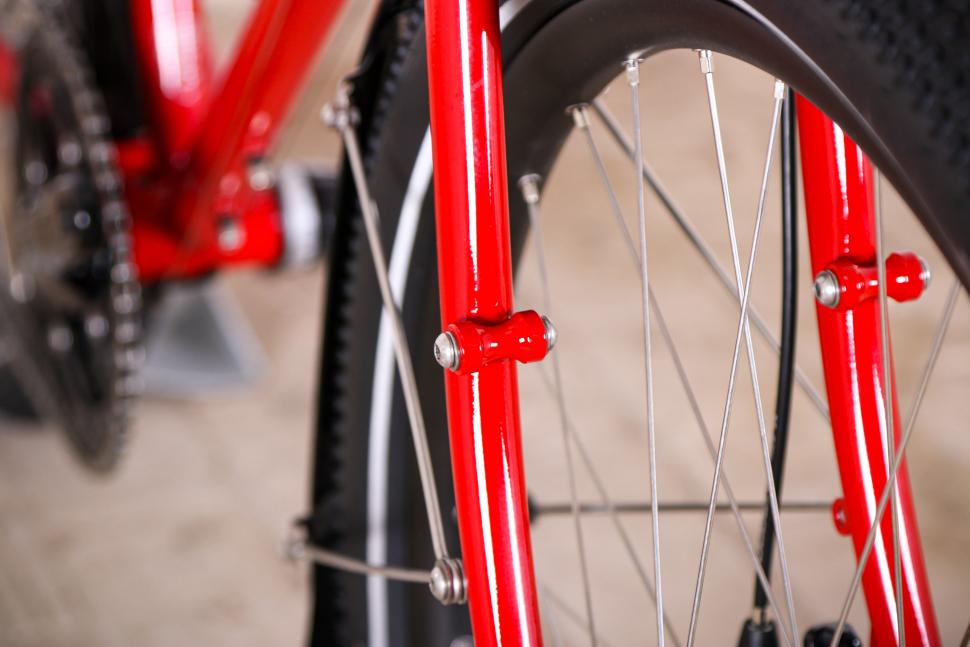




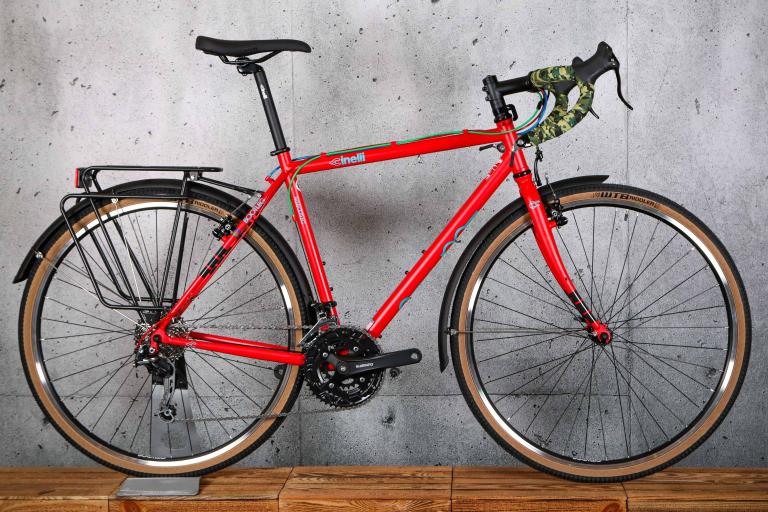
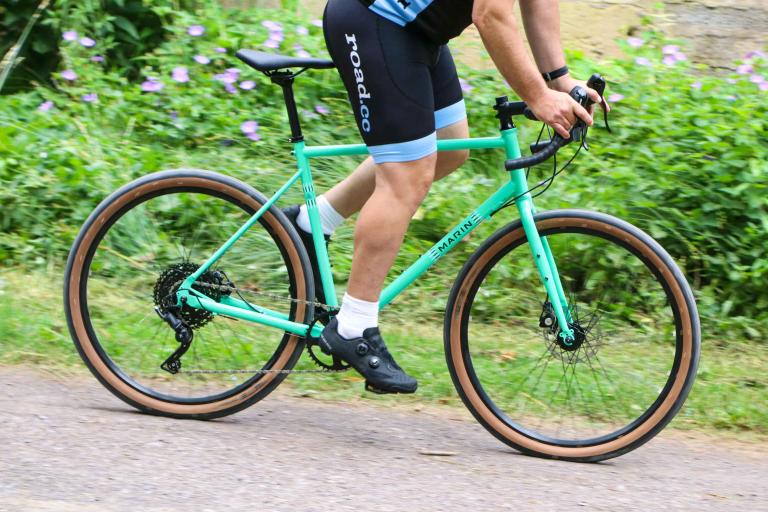
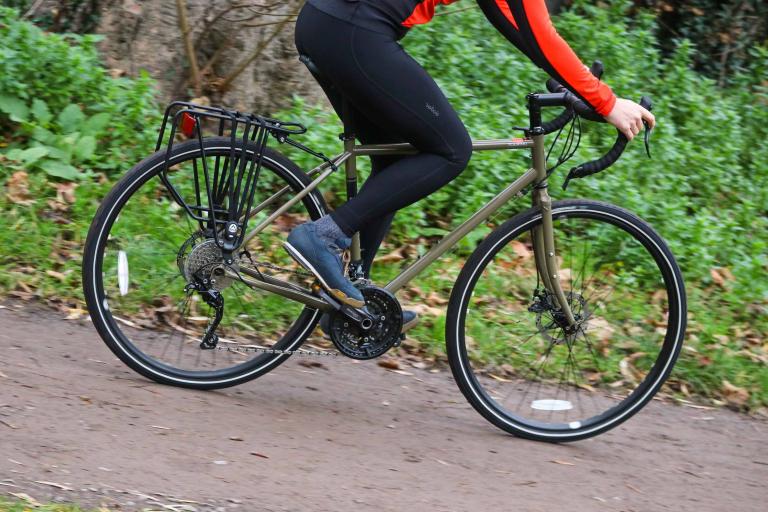
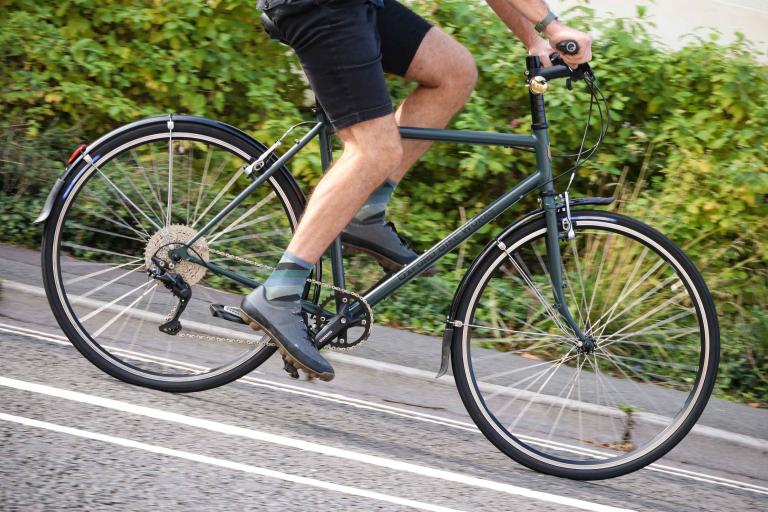
Add new comment
12 comments
I've just built a 700c tourer based on the Club Tour 5. Could I ask if anyone knows which mudguards are used on this reviewed bike. The sks chromoplastic I normally use don't look ideal.
They do appear to be SKS Chromoplastics - if you look at Image #35 in the main gallery you can actually see the label. They look very similar to e.g. these ones: https://www.chainreactioncycles.com/sks-chromoplastic-city-mudguard-set/...
I do get confused by SKS's range and they seem to change them all the time, so they might look different to other Chromoplastics!
A spectacularly ugly bike. 'Jolly tractor' is the right descriptor as honestly it looks like a farm gate.
Sorry to sound harsh, but it's quite possible to make a bike with go anywhere features without looking like it was designed in 1990 then dragged through a hedge backwards.
Intrigued by the factory-fit 105/Deore mix - i'm guessing it's a 9-speed Deore rear mech then ? (not that it cares about the number of cogs..)
I can't understand why anyone would buy this over a similarly specced but much cheaper gravel bike or endurance road bike. Modern bikes are so versatile now why would anyone want the faff of a triple and the weight of this frame for such a high price.
They are different kind of bikes. This is a "round the world" tourer designed to carry heavy loads.
And triples are awesome.
For a tourer, and one specced with low rider rack mounts at the front, the lack of rear rack mounts must be a first. It's almost like someone forgot to tick a box on the contract spec.
The position of the rear disc caliper looks like you'll need the awkward disc version of a rack to straddle the caliper. Also looks to be in contention with the mudguard stay. At this price I'd expect the details to be correct.
Regarding disc-only fork, what are the three pairs of mounts either side of the rim for?
It has rack mounts and is designed to work with their standard rear rack, which is why the disc caliper is where it is. Their racks have specific mudguard mounts to make a much more stable mudguard. Thorn have been doing touring bikes for forever, they know how to make a reliable bike.
Check out their website. https://www.thorncycles.co.uk/bikes
I tried to buy one 10 years ago, but couldnt get one in time. I wish i had as the bike i bought was not nearly as well thought out as a Thorn.
Thanks. I didn't know that about their rear racks, that they came with mudguard mounts. Doesn't seem to have been uppermost in the mind of the reviewer either!
So really, you're tied to using their rack. I'm sure it's a great rack, but it's certainly not the only one.
I've taken another look at the fork thing - I've confused the seat stays for the forks. Oops!
Yeah, the frame is designed with those bosses to allow rim brake boss to be bolted on for 2 positions for different size wheels. The Thorn owners/designers have been pretty anti-disc (or really more pro rim-brake) for touring due to simplicity and ride quality. Discs require stronger fork legs and frame stays, so for a comfy bike they often recommend a rim brake fork as the legs can be thinner and gives a more comfortable ride. They list this bike in a lot of custom builds including with their lightweight rim brake fork (which i have on a bike and is REALLY comfy!), so i guess they wanted this frame to also have the option of rim brakes, but you cant sell a bike without a disc option these days so they have come up with this solution.
Their rear rack is supposed to be really good, its a proper touring rated rack and any review gives it good results, yeah other options would be nice but you would be buying this bike as a custom built from them, not your LBS, so i dont think thats an issue.
Yes - for many years Thorn put loads of shouty text in their epic brochures about the evils of disc brakes and steel forks and so produced some spectaculalry ugly bikes with rear dics and front v-brakes aka Brake Mullets. I can see the their point but really, it's a bike, so good to see they have got over themselves and applied themselves to getting with the times and taking on-board the advantages of things like disc brakes and through axles. Bet you they sell quite a lot of these; bombrpoof, modern standards, tons of variety. Almost makes me want to tour a bike, which is saying something!